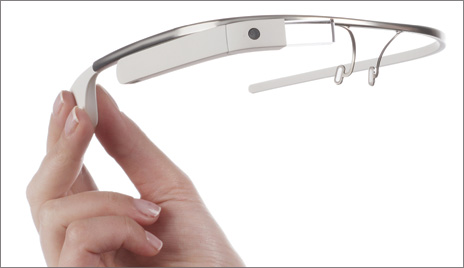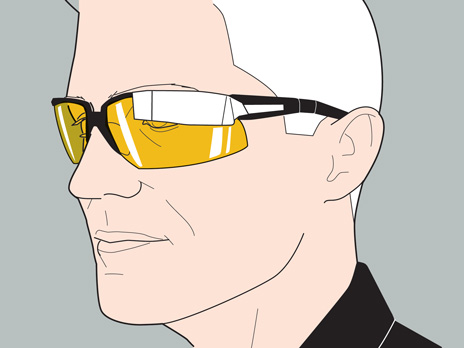Google Glass update
January 2, 2013

Google Glass will let you access information “so fast that you feel you know it,” says Project Glass leader Babak Parviz (credit: Google)
Summary of an IEEE Spectrum report
In the next few weeks, Google will start shipping its Google Glass to developers. More-polished consumer models are expected in 2014.
Details about Glass are still sketchy but here’s what we know:
- The lightweight browband, which looks like an ordinary pair of reading glasses minus the lenses, connects to an earpiece that has much the same electronics you’d find in an Android phone: a microprocessor, a memory chip, a battery, a speaker, two microphones, a video camera, a Wi-Fi antenna, Bluetooth, an accelerometer, a gyroscope, and a compass. The microdisplay is positioned over one eye.
- That hardware lets Glass record its wearer’s conversations and surroundings and store those recordings in the cloud; respond to voice commands, finger taps, and swipes on an earpiece that doubles as a touch pad; and automatically take pictures every 10 seconds. Prototypes connect to the Internet through Wi-Fi or through Bluetooth and a smartphone. Future versions will likely include a cellular antenna.
- Glass will run apps like Google+ and Google Search, but it’s designed to feel more natural and immersive than a PC or a smartphone. Ideally, Babak Parviz, the leader of Project Glass, told developers at the company’s Google I/O conference in June, it will let you access information “so fast that you feel you know it.”
Start-ups Atheer, First Person Vision, Lumus, and Vergence Labs all have Glass-like prototypes in the works. Specialty manufacturer Recon Instruments makes MOD Live, a head-up display for skiers that analyzes their jumps. Established firms like Apple, Microsoft, Olympus, and Sony have been conducting research into smart glasses and head-up displays for years.
Full disclosure: KurzweilAI.net CEO Ray Kurzweil is now a Google executive.
Google Glass Features and Apps Still in Flux
Babak Parviz, head of the Google Glass project, hints at what to expect next:
- We wanted to have a device that would do two things that we think would be useful for a lot of people. One is to have a device that would allow for pictorial communications, to allow people to connect to others with images and video. The second big goal was to have a technology that would allow people to access information very, very quickly. So when you have a question, you can very rapidly get to the answer.
- In the future, augmented reality will also come into the picture. So augmented reality is exciting when you think about future generations of this type of wearable computing
- A touch pad on the device allows people to change things on the device if they wish to do so. We have also experimented a lot with using voice commands. We have full audio in and audio out, which is a nice, natural way of interacting with something that you’d wear and always have with you. We have also experimented with some head gestures.
- I think since our platform allows for very quick access to information—if you need to have access to visual information, you almost instantly get it—something like Google Now could be very compelling.
Build Your Own Google Glass

(Illustration credit: Jason Lee)
By AI researcher and investor Rod Furlan
I needed a microdisplay with a screen between 0.3 and 0.6 inches diagonally, and with a resolution of at least 320 by 240 pixels. Most microdisplays will take either a composite or VGA video input, the former being the easiest to work with.
A quick search on the Alibaba global supply website returned several candidates; most suppliers will gladly fulfill orders for a single display and matching control electronics if you contact them directly. However, the corresponding optics for mounting these displays—which required them to be placed directly in front of the eye—were too bulky.
To build a sleek device, I needed to be able to mount the actual display on the side of the head and bring the image around to the eye. This setup is actually easy to make if you have the right equipment, which I don’t. Luckily, back in 2009, a company called Myvu (now out of business) sold a line of personal head-mounted video displays for iOS devices. Myvu’s products were sleek and small because they used a clever optical system alongside side-mounted screens. …
(More)